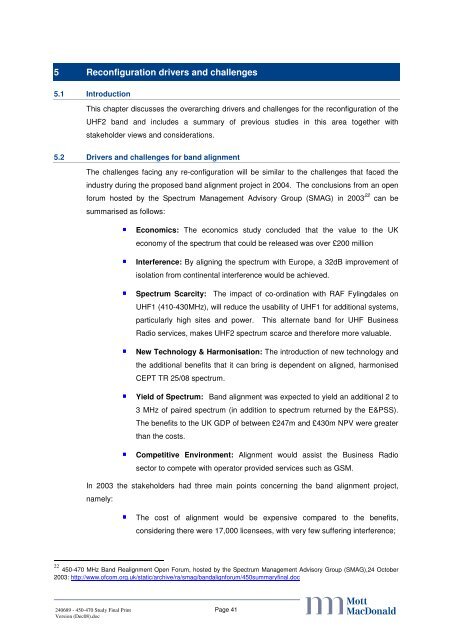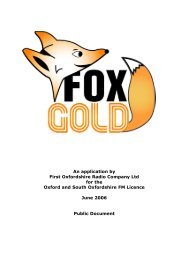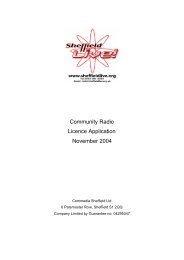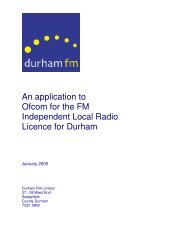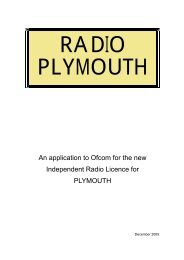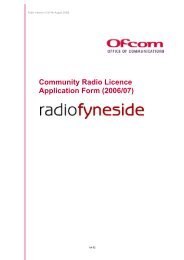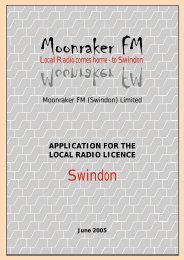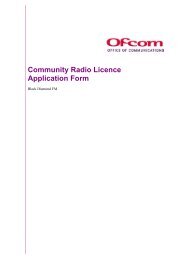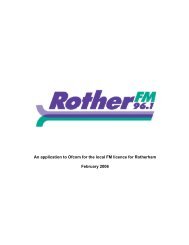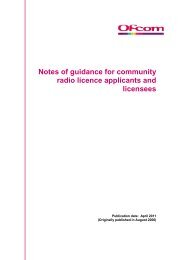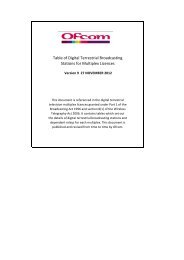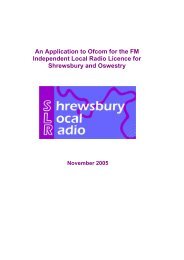UHF2 realignment study - Ofcom Licensing
UHF2 realignment study - Ofcom Licensing
UHF2 realignment study - Ofcom Licensing
You also want an ePaper? Increase the reach of your titles
YUMPU automatically turns print PDFs into web optimized ePapers that Google loves.
5 Reconfiguration drivers and challenges<br />
5.1 Introduction<br />
This chapter discusses the overarching drivers and challenges for the reconfiguration of the<br />
<strong>UHF2</strong> band and includes a summary of previous studies in this area together with<br />
stakeholder views and considerations.<br />
5.2 Drivers and challenges for band alignment<br />
The challenges facing any re-configuration will be similar to the challenges that faced the<br />
industry during the proposed band alignment project in 2004. The conclusions from an open<br />
forum hosted by the Spectrum Management Advisory Group (SMAG) in 2003 22 can be<br />
summarised as follows:<br />
240689 - 450-470 Study Final Print<br />
Version (Dec08).doc<br />
Economics: The economics <strong>study</strong> concluded that the value to the UK<br />
economy of the spectrum that could be released was over £200 million<br />
Interference: By aligning the spectrum with Europe, a 32dB improvement of<br />
isolation from continental interference would be achieved.<br />
Spectrum Scarcity: The impact of co-ordination with RAF Fylingdales on<br />
UHF1 (410-430MHz), will reduce the usability of UHF1 for additional systems,<br />
particularly high sites and power. This alternate band for UHF Business<br />
Radio services, makes <strong>UHF2</strong> spectrum scarce and therefore more valuable.<br />
New Technology & Harmonisation: The introduction of new technology and<br />
the additional benefits that it can bring is dependent on aligned, harmonised<br />
CEPT TR 25/08 spectrum.<br />
Yield of Spectrum: Band alignment was expected to yield an additional 2 to<br />
3 MHz of paired spectrum (in addition to spectrum returned by the E&PSS).<br />
The benefits to the UK GDP of between £247m and £430m NPV were greater<br />
than the costs.<br />
Competitive Environment: Alignment would assist the Business Radio<br />
sector to compete with operator provided services such as GSM.<br />
In 2003 the stakeholders had three main points concerning the band alignment project,<br />
namely:<br />
The cost of alignment would be expensive compared to the benefits,<br />
considering there were 17,000 licensees, with very few suffering interference;<br />
22 450-470 MHz Band Realignment Open Forum, hosted by the Spectrum Management Advisory Group (SMAG),24 October<br />
2003: http://www.ofcom.org.uk/static/archive/ra/smag/bandalignforum/450summaryfinal.doc<br />
Page 41<br />
abc


